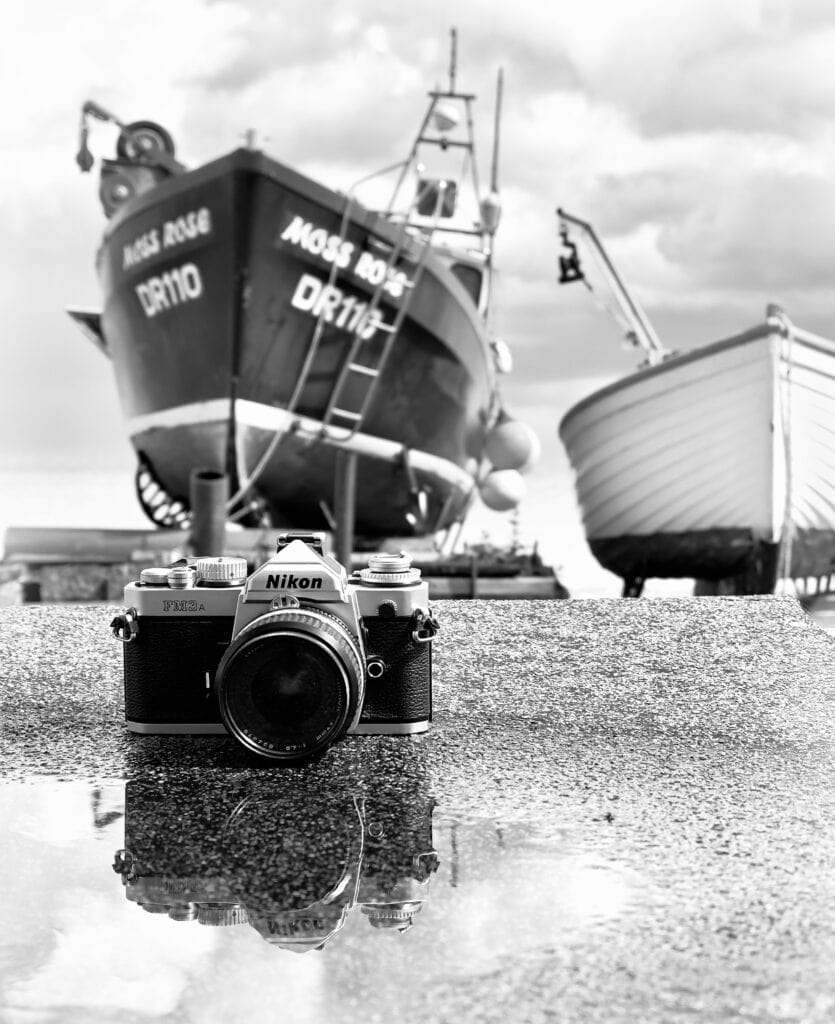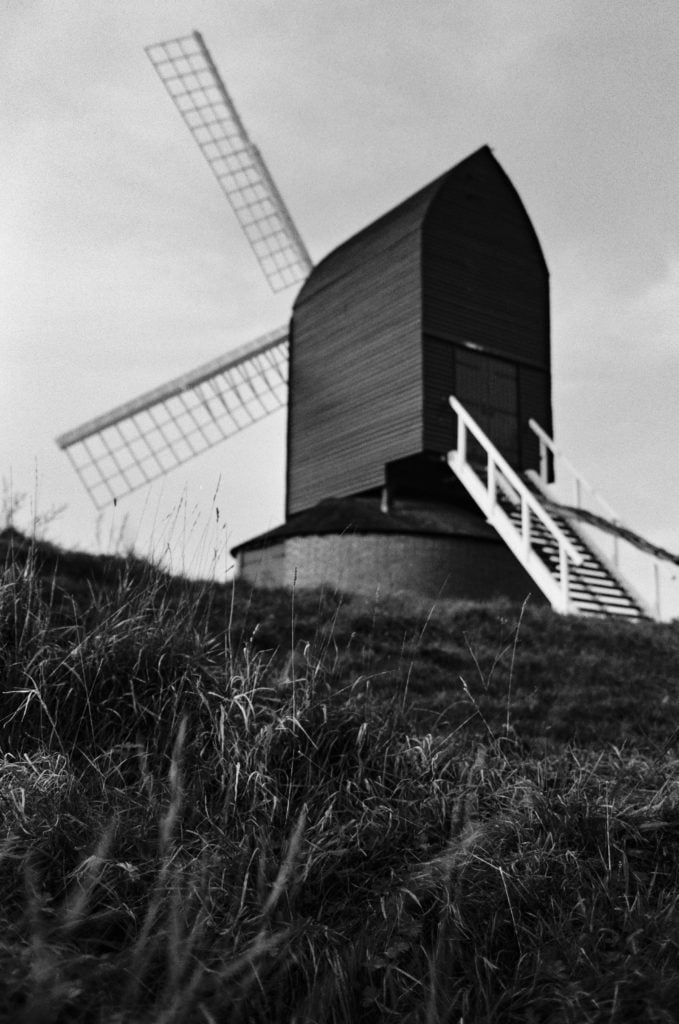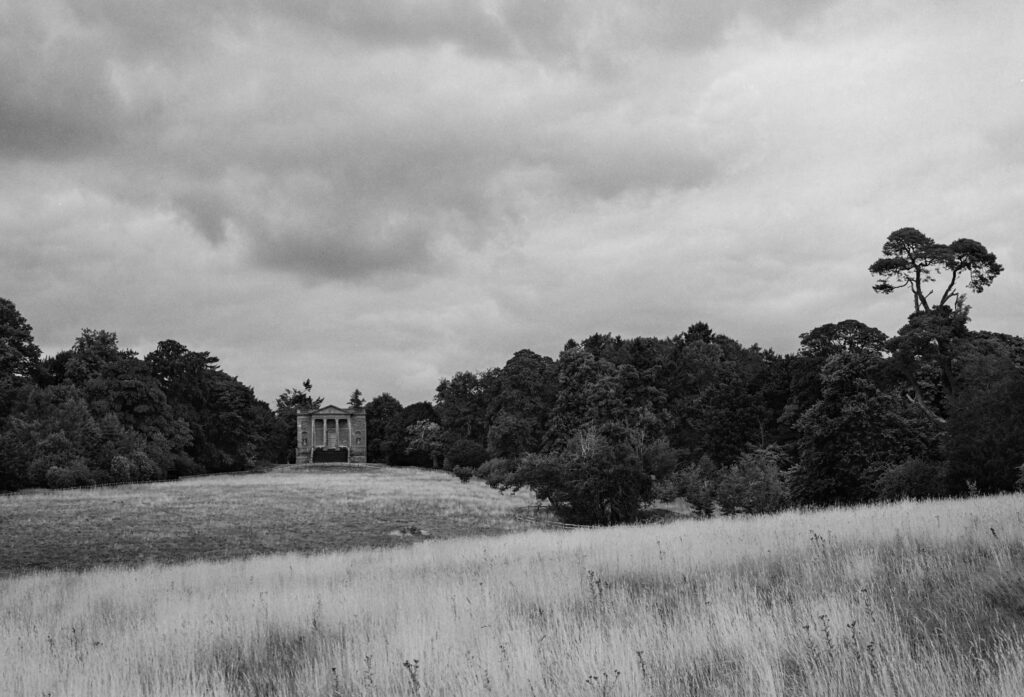This year by year camera timeline lists significant milestones and cameras representative of the year, as well as some curiosities and evolutionary dead-ends, from 1900.
The timeline does not include developments in lenses, film processes or camera phones. These can be found in the history of photography timeline – from chemistry to computation. There is also a timeline for nineteenth century cameras on the site. The cameras shown here are from my own collection.
1900-1920

- 1900 Kodak introduces the first of the Brownie series which brings the snapshot to the masses. It is a cardboard box camera with a simple meniscus lens that takes 2 1/4-inch square pictures on 117 roll film
- Kodak markets the The No. 3 Folding Pocket Kodak Camera, a camera that would go on to have probably the largest number of model variations of any Kodak camera made
- 1901 The Kodak No.2 Brownie is the first camera to use 120 roll film
- 1902 The Royal Ruby is introduced by Thornton-Pickard, an early pioneer in the development of the camera industry, as its top of the range field camera
- 1903 The Century Camera Co. introduces the Grand Century Senior. It is constructed of mahogany and features a revolving back and triple extension bed in addition to front standard adjustment
- 1904 Century introduces the No. 2 Field Camera offering front and rear focus via rack and pinion; double swing; reversing by removable back and a three-piece lens board for 5 x 7, 6.5 x 8.5 and 8 x 10 inch plate film
- The No. 4 Screen Focus Kodak combines the use of roll film with a ground glass with an unusual construction that allows the roll film back to be swung out of the way to make place for the ground glass
- 1905 The Soho Reflex single-lens reflex camera is introduced and becomes the definitive SLR model until after WWII
- Houghtons Limited introduces the Ticka Watch Pocket Camera. It is about 2½ inches in diameter with the lens mounted in the barrel and the film in a cassette
- 1906 Kodak markets the No. 4A Folding Kodak, a large camera for amateur photographers, producing negatives of 4 1/4 x 6 1/2 inch on roll film or glass plates
- 1907 The Revolving Back Auto Graflex camera is first patented by the Folmer and Schwing division of the Eastman Kodak company. The camera’s main feature is a revolving back for taking horizontal or vertical pictures without having to rotate the camera
- The Butcher Royal Mail Stamp Camera is the simplest type of multiplying camera, featuring a polished mahogany box with fifteen lenses, an internal septum to separate the images, and spring mounted metal plate shutter to produce fifteen images on small 3-1/4″ x 4-1/4″ dry plates or film
- 1908 Kodak markets the No. 4A Speed Kodak, a specialist camera for the professional or serious amateur photographer offering shutter speeds from 1/5 to 1/1000 of a second
- 1909 The 1A Graflex SLR is introduced. It shoots 2¼ x 4¼ inch Kodak 1A roll film and is notable for its pantograph viewing hood
- Houghtons Ltd. introduces the Ensignette Camera, an all metal bellows camera which folded into a vest pocket size camera like the Kodak VPK. It is a milestone in popular photography, providing for the first time a practical, truly compact camera at an affordable price to the average person
- 1910 Kodak launches the No. 2A Folding Pocket Brownie folding roll film camera for 116 film producing 2 1/2 X 4 1/4″ images
- 1911 Newman & Guardia Ltd introduces the Model 11A Postcard Sibyl for 5 ½” x 3 ½” plates featuring a folding reflecting view-finder with spirit levels
- c. 1911 The original Makina model is launched by Plaubel. It is a strut folding press-type camera, taking 6 x 4.5cm film plates
- 1912 The first Speed Graphic press cameras are produced. Production continues until 1973
- The Vest Pocket Kodak camera, or ‘VPK’ as it was usually known, is launched and becomes one of the most popular and successful cameras of its day. Over 2 million would be sold before the model was discontinued in 1926.
- 1913 The Homeos stereo camera is the first 35mm camera to go into production
- The first commercially successful 35mm camera is the American Tourist Multiple produced by Herbert & Huesgen, New Ideas Mfg. Co
- 1914 Oskar Barnack, creates the Ur-Leica, the prototype of a small-format 35mm camera
- Kodak introduces the No. 0 Brownie, the smallest in the range. It takes pictures the same size as the popular Vest Pocket Kodak of 1912
- 1915 The Minnigraph, made by Benno Levy-Roth of Berlin, may be the first still camera to use cine film. It makes what will later be considered half-frame (18 x 24 mm) pictures, on film held in special cassettes
- 1916 Kodak introduces the 3A Autographic Special. Generally regarded as the first rangefinder camera, it has a 3-band split-image coupled rangefinder built into the base of the front standard
- c. 1917 Conley’s Kewpie No. 3A is a postcard format box camera for type No. 125 roll film with two reflecting type finders, one for horizontal and one for vertical exposures
- 1918 The Adam, a cardboard box camera, is the first Japanese camera to sell for ¥1
- 1919 The Cocarette is one of the first new products of German camera maker Contessa-Nettel after the merger that led to the foundation of that company in 1919.
- 1920 The Venus is a folding camera made by Ihagee in Dresden optimized for exposures in horizontal format
1921-1930
- 1921 Newman & Guardia Ltd launches the N&G Folding Reflex with a collapsible focusing screen and mirror
- The Paff-Reflex is introduced by Ihagee. It is the first SLR made by the company which will later introduce the first 35mm SLR
- 1922 The Ensign Cupid is the first camera to use a ‘double window’ arrangement for doubling the number of exposures on a roll
- 1923 J.H. Dallmeyer Ltd introduces the Dallmeyer Speed with a a fast focal plane shutter capable of providing speeds up to 1/1000th of a second accompanied by a fast Pentac F2.0 lens.
- 1924 The first common wide aperture lens becomes available with the f/2 Ernemann Ermanox, manufactured by Heinrich Ernemann A.G. of Dresden
- 1925 Leica introduces the Leica I (A), a watershed design that makes the 35mm format truly viable
- c. 1926 The Agfa Standard medium format roll film and plate cameras become available with an optional coupled coincident rangefinder at extra cost. Ingenious and advanced for their time, they would serve as the inspiration for later Zeiss Super Ikontas and Voigtlander Bessas
- 1927 The first monorail camera, the Stegemann Studien-Kamera-C, a 9 ×12 model is designed by the Pictorialist photographer Heinrich Kuhn
- 1928 The hugely influential Rolleiflex twin lens reflex camera (TLR) is introduced, with an ingenious focusing mechanism using a the carriage that held both the viewfinder and the imaging lens, achieving the same function as bellows but with metal
- 1929 Zeiss-Ikon introduces its top product line of folding medium format cameras, the Ikonta
- Minolta, originally named the Nichi-Doku (which means “Japan-German”) Photographic Company, introduces its the first camera, the Nicalette, which is equipped with a German shutter and lens.
- 1930 The Leica I (C) offers a camera with interchangeable lenses using the Leica Thread Mount (LTM)
1931-1940
- 1931 The first 35mm prototype SLR is the Filmanka developed by A. Min in the Soviet Union
- 1932 The Leica II is launched, the first Leica camera with a rangefinder, which becomes a signature of the company
- Zeiss Ikon produce the Contax I to compete with the Leica II
- This Rolleiflex Standard K2 Twin Lens Reflex upgrades the original camera with several significant features, including support for 120 format roll film, a film rewind crank, sports finder, removable back and exposure counter
- The first Voigtländer Brillant is released, resembling a TLR but functionally closer to a box camera, since it cannot be focused in the viewfinder using zone-focusing.
- 1933 The Leica III is introduced – a response to the introduction of the Zeiss-Ikon Contax and Oskar Barnack’s last design. It will remain in production in various iterations until 1960
- Kodak introduces the The Jiffy Kodak Six-20, a folding camera for 620 film with a Twindar periscopic lens with zone focusing and three selectable apertures
- The first Rolleicord is introduced, a simplified version of the Standard Rolleiflex
- 1934 Zeiss Ikon introduces the Super Ikonata folding camera, which takes 16 4.5 x 6cm images on 120 film and is equipped with a coupled rangefinder
- Kodak enters the 35mm market with the Retina I which introduces the 135 cartridge used in all modern 35 mm cameras.
- Berning introduces the Robot I camera with a stainless steel body, a spring drive that can shoot at 4 frames per second, and a rotary shutter with speeds from 1 to 1/500th second
- Houghton-Butcher introduces the Ensign Midget, a tiny roll film strut folder with a 3-speed shutter
- 1935 The Leica IIIa is released with a top speed of 1/1000th of a second
- 1936 the first widely-distributed 35mm SLR camera, the Kine Exakta, is introduced, with a design that will influence many subsequent SLRs
- Canon introduces the Hansa, the first Asian 35mm camera
- Zeus Ikon launch the Contax II, the first camera with a rangefinder and a viewfinder combined in a single window
- 1937 Franke & Heidecke unveil the Rolleiflex Automat which features an ingenious automatic first frame positioning and frame counting system which monitors the length of the film as it passes between rollers and sets the camera accordingly, eliminating the need for a red window
- Russian manufacturer GOMZ introduces the Sport. Designed between 1934 and 1935 It is the earliest known production 35mm SLR camera ever to be built, but fewer than 320 examples were made and is overshadowed by the Kine Exacta.
- Swiss watch maker Jaeger LeCoultre & Company manufacture the ultra compact Compass for the Compass Cameras Ltd. of London, one of the most complicated miniature camera ever made. Measuring a mere 6.5×2.5×5.5cm, it packs a multitude of features into its trim body
- The Purma Special (named after the founders Tom Purvis and Alfred Mayo) is a British 127 roll film viewfinder camera with an innovative gravity controlled shutter
- 1938 Kodak Introduces the Super Six-20, the world’s first camera with built-in photoelectric exposure control
- Leica introduces the first commercially successful 35 mm motordrive, the mechanical MOOLY
- The Leica IIIb is released with a redesigned viewfinder optic, which brings the RF and VF eye pieces close together
- British camera manufacturer Gandolfi launches the Precision, a development of the Imperial model introduced in 1899, which will remain on sale into the 1970s
- Voigtländer introduces the Focusing Brillant adding a small opaque spot in the brilliant finder
- 1939 The Praktiflex 35mm SLR is launched by the Kamera-Werkstätten AG. The design is simple but will constitute the pattern along which virtually every subsequent 35mm SLR camera will be built, regardless of place of origin
- The Argus C3 is introduced and becomes the world’s best-selling 35mm camera, offering affordable 35mm rangefinder photography to amateurs
- 1940 The Leica IIIc is introduced in 1940 with a total redesign of the body and shutter crate. It will remain the mainstay of Leica’s line-up through out the 1940’s
- The Mamiya Six is introduced, offering a unique 6 x 6cm coupled rangefinder with film-plane focusing
1941-1960
- 1941 The Kodak Ektra offers a rangefinder that could accurately focus a 153mm telephoto and the first complete anti-reflection coated lens line for a consumer camera
- 1942 The F24 aerial reconnaissance camera is developed into the F52 model with an image format of 8.5 ×7 inches and magazines up to 500 exposures
- 1943 the FS-3 FotoSniper prototype is developed by GOI for the Soviet Baltic Fleet Navy as a long-range reconnaissance camera. It has a FED body and a 60cm lens with an f4.5 aperture
- 1944 The Alpa-Reflex 35mm SLR is presented to the public at the Swiss Trade Fair in Basel
- 1945 Houghton-Butcher introduces the Ensign Commando, a folding coupled-rangefinder 6 x 6cm camera for the British Military. It is released so late in the war it does not see much active service
- 1946 Houghton-Butcher introduces a dual format civilian version of the Ensign Commando offering the smaller 6 x 4.5cm format in addition to 6 x 6cm
- The Universal Camera Corporation offers the Mercury II which adds support for normal 35mm film rather than the proprietary Univex film used in the original. Both Mercury cameras use a unique rotary focal plane shutter that enable a maximum shutter speed of 1/1000 second whilst keeping costs low
- 1947 Konishiroku introduces the Konica (later known as the Konica I), a knob-wound camera with a single eyepiece for a coupled rangefinder and viewfinder, based on an earlier camera called Rubikon, developed c.1938
- The Bolsey B is introduced, a 35mm rangefinder camera with a finely cast aluminium body
- 1948 Instant photography is introduced with the first instant-film camera, the Land Camera 95 or Polaroid camera
- The Gamma Duflex is the first SLR camera with an instant return mirror. Production is limited and few models find their way beyond the domestic Hungarian market and so the later Asahiflex IIb is often credited with this innovation
- Hasselblad launches the1600F, a 6 × 6cm format focal-plane shutter SLR camera with a revolutionary modular design that allows lenses, viewfinders and film magazines to be exchanged
- The Nikon 1 is released, the first Nikon-branded camera, featuring a smaller than standard picture format which produces up to 40 negatives from a single roll of 36 exposure film.
- 1949 Contax S camera is introduced, the first 35mm SLR camera with a pentaprism eye-level viewfinder
- The Canon II B is launched with a three-mode optical viewfinder offering magnifications from 0.67x to 1.5x to match the focal length of the lens fitted.
- The Ilford Advocate is introduced, the first British 35mm camera introduced after WWII. It is made of white-enamelled die-cast aluminium alloy
- Nikon releases the second iteration of the Nikon rangefinder, the Nikon M, with a slight increase in picture size from 24mm x 32mm, to 24mm x 34mm
- 1950 The Leica IIIf is launched, offering built-in flash synchronization
- Voigtländer introduces the Bessa II, the ultimate iteration of the model first available in 1929 and offering a combined viewfinder and rangefinder and 6 x 9 images
- Voigtländer launches the Perkeo 6 x 6 folding camera. Measuring just 125 x 85 x 40mm when closed, and 95mm deep when the lens is extended it is one of the smallest medium format camera.
- The Agiflex II is a 6×6 SLR, made by Agilux and derived from the British WWII military aerial camera ARL that was in turn derived from the German Reflex Korelle
- 1951 The Nikon S becomes available, retaining the unusual 24mm x 34mm format
- The Ilford Witness, an advanced 35mm coupled-rangefinder camera, is introduced with either a 2-inch f/1.9 Dallmeyer Super Six, or a 5 cm f/2.9 Daron. Production difficulties led to less than 350 cameras being made
- The WrayFlex I is a British SLR which uses two mirrors instead of a pentaprism, so the image is reversed and not very bright. It has a full complement of speeds from ½sec to 1/1000th sec in the focal plane shutter.
- 1952 Kodak introduces the Brownie 127, a plastic box camera with no aperture or focus controls, and a single-speed shutter that produces eight 4 x 6 cm pictures on 127 film. It rapidly becomes an extremely popular snapshot camera in Britain with over a million made.
- The Asahiflex, built by the Asahi Optical Corporation (later to become Pentax), is the first SLR camera built in Japan
- The Canon Camera Company markets the Canon IVSb 35mm rangefinder, the first 35mm camera to support flash sync for both flash bulbs and electronic X-sync through Canon’s proprietary rail mounted flash shoe
- 1953 The Coronet 6×6 Flashmaster is introduced with a rigid Bakelite body, a fixed lens and a simple shutter with no aperture or speed setting
- The Graflex KE-4 Combat Camera, a 70mm model, is manufactured for the military. Since the design resembles a giant Contax camera it is given the nickname “Gulliver’s Contax”
- The Periflex 35mm camera is launched by K. G. Corfield Ltd. It resembles the Leica Standard, Model E but provides through the lens visual focusing using an inverted periscope lowered into the light path between the lens and the film
- 1954 The Leica M is introduced with the new Leica M mount and popularises the combined rangefinder and viewfinder
- Nikon introduces the S2 rangefinder that takes conventional 35mm film and a 1.0X finder. It offers the option to attach the world’s first battery powered motor drive
- The Asahiflex IIb is the first volume 35mm SLR with an instant return mirror. Early SLRs left the mirror in its up position until the camera was wound for the next shot, blacking out the viewfinder. The introduction of instant-return mirror mechanisms and the subsequent elimination of mirror blackout is an important step in the acceptance of SLRs
- 1955 The Miranda T 35mm SLR camera is launched by the newly established Japanese Orion Camera Co. It is the first Japanese 35mm SLR camera with an eyelevel Pentaprism finder.
- 1956 The Rolleiflex 2.8E is the company’s first model with a built in, uncoupled light meter as an option
- The VT is Canon’s first camera to have a camera back which swings open for film loading. The film advances with a fast-winding trigger at the camera bottom instead of a knob on top.
- 1957 The Asahi Pentax SLR is introduced, placing controls in locations that would become standard on 35 mm SLRs
- Tokyo Kogaku KK launch their first 35mm SLR camera, the Topcon R, ahead of Nikon and Canon
- Leitz releases the Leica IIIg as the final model in the series with a newly designed top cover with a larger and improved viewfinder
- The Nikon SP is the worlds first rangefinder to include built-in frame lines for 6 different focal lengths
- Hasselblad introduces the medium format 500 C, which will go on too become one of most influential and successful cameras of all time
- 1958 The Minolta SR-2 is the first SLR camera with an automatic diaphragm which maintains maximum aperture for brightest viewing and stops down only when the picture is taken
- Nikon releases a new rangefinder, the S3, a stripped down version of the Nikon SP at a lower price
- Konishiroku introduces the Konica IIIA with three finder windows and offering 1.0× finder magnification
- 1959 The Nikon F is introduced, marking the transition from rangefinders to SLRs for professional photographers
- Canon introduces the Canonflex, its first SLR
- The Olympus Pen is the first half-frame camera produced in Japan. It is one of the smallest cameras to use 35mm film in regular 135 cassettes.
- The Zenza Bronica is the first Japanese 6 x 6cm format camera with interchangeable lenses and film backs
- 1960 Konishiroku introduces the Konica F, featuring the Hi-Synchro, the first SLR shutter with a speed of 1/2000s
- Nikon introduces the S3M, a half-frame variant of the Nikon S3 with a modified viewfinder and a frame counter that displays up to 72 exposures
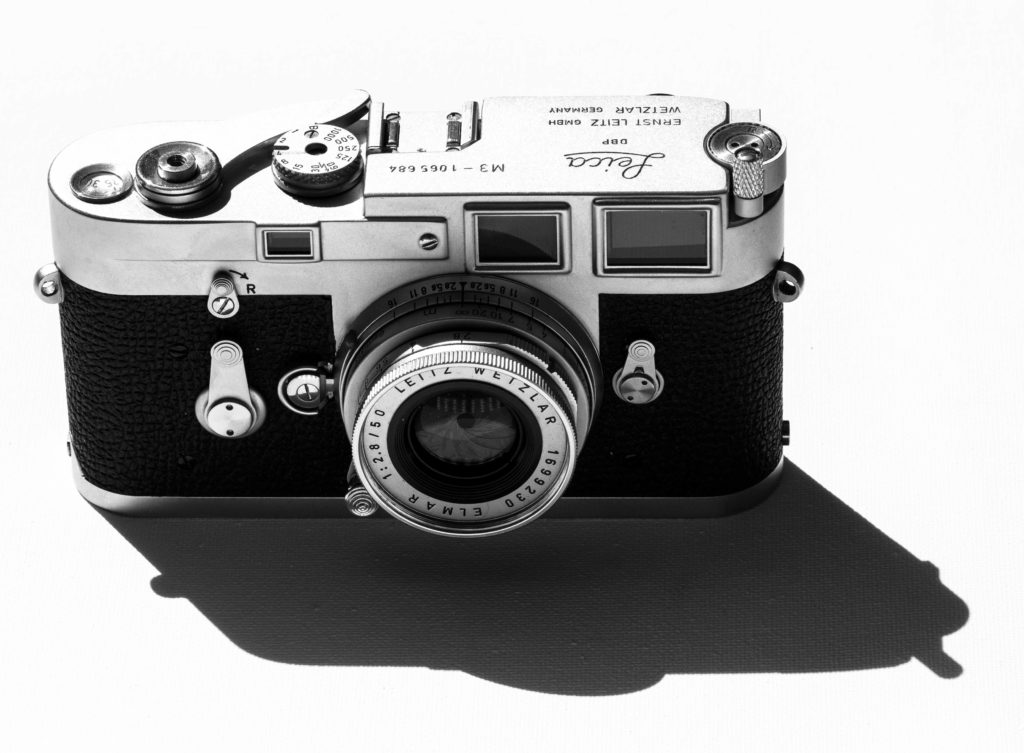
1961-1970
- 1961 Canon introduces the Canonet, a mid-market 35mm camera with a fast f/1.9 lens. Two and a half years later, a million Canonets had been sold.
- 1962 AGFA introduces the first fully automatic camera, the Optima, with an automatic programmed exposure, using a selenium-meter-driven mechanical system
- The Nikkorex F is the first production single-lens reflex camera with the metal Copal square shutter
- 1963 Kodak introduces the Instamatic range of cameras, with an easy-to-use film cartridge and the phrase ‘load it you’ll love it’
- The first SLR with TTL light metering is the Topcon RE Super, which has the CdS metering cell placed behind the reflex mirror.
- Olympus introduces the Pen F, a compact half-frame 35mm SLR that supports interchangeable lenses and a distinctive logo rendered in a gothic font
- The world’s first full-fledged underwater camera goes on sale in Japan – the Nikonos 1
- 1964 The Pentax Spotmatic SLR is introduced with revolutionary stop-down light metering
- 1965 The Konica Auto-Reflex of 1965 is the first focal-plane-shutter auto exposure 35mm SLR. This is not TTL metering, although it does offer a shutter-preferred, auto-exposure mode
- Hasselblad launches a new design, the 500EL, with an electric motor integrated into the camera body
- Eastman Kodak replaces the individual flashbulb technology used on early Instamatic cameras with the Flashcube
- The Practica mat by VEB Pentacon Dresden is the first 35 mm single-lens reflex camera with TTL exposure metering
- 1966 The Electro 35 rangefinder camera is introduced by Yashica with a coupled and fixed 1:1.7 45 mm lens. It is the first electronically controlled rangefinder camera offering aperture priority ‘auto’ mode
- The Rollei 35 becomes the smallest 135 film camera
- The Olympus Pen FT updates the F model with a single-stroke film advance and an uncoupled, integrated light meter
- 1967 Nikon F Photomic SLR is the first camera with a centre-weighted exposure metering system
- 1968 Leica introduces the Leicaflex SL, the world’s first single-lens reflex camera with a precisely defined microprism zone for TTL spot exposure metering displayed in the viewfinder.
- Konishiroku launches the Konica C35, combining light weight and compact size with the simple operation of “auto only” exposure
- 1969 The Olympus-35 EC, an electronically controlled 35mm compact camera, is introduced. It features a fixed Zuiko 42mm f/2.8 lens and and an automatically controlled Seiko shutter with a range of 4 to 1/800 sec
- The Mamiya C220 is released as part of the Mamiya C series of interchangeable lens medium format TLR cameras
- 1970 The Sinar P 4×5 sets the standard for high-end, large format cameras with asymmetric tilts and swings, as opposed to traditional centre or base tilts.
1971-1990
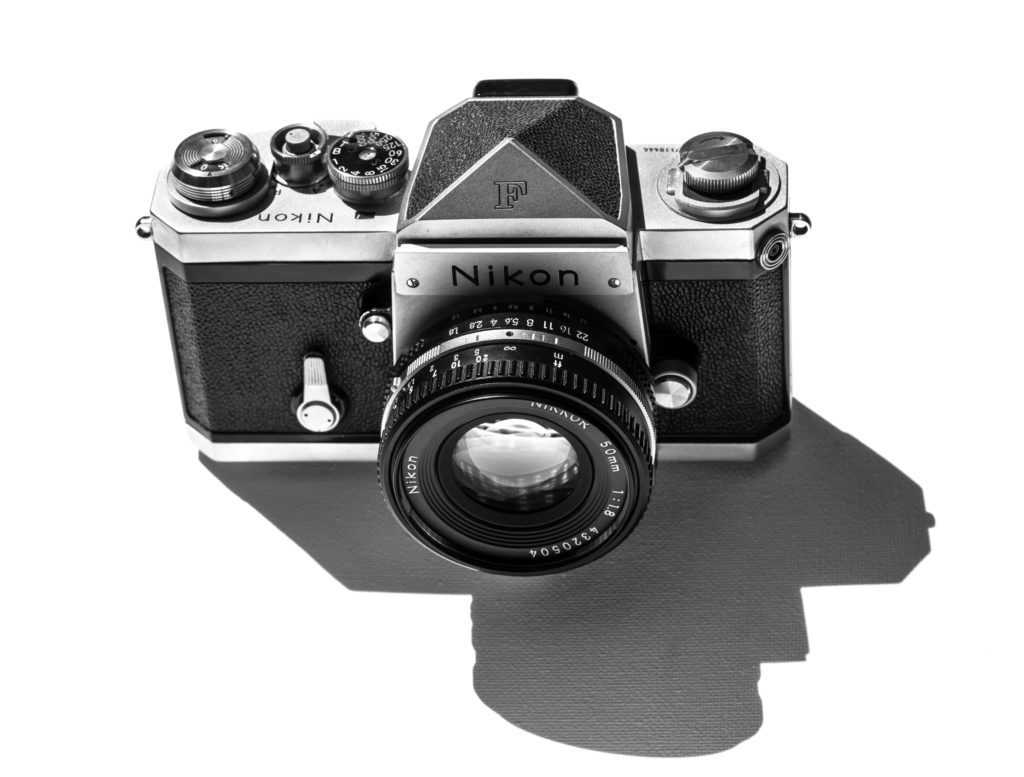
- 1971 The Canon F-1 is introduced, a highly durable model built to endure 100K picture-taking cycles, temperatures from -30 C to 60 C, and 90% humidity.
- Nikon’s F High Speed Motor Drive camera, developed for the ’71 Chicago Photo Expo offers a blazing 7 frames per second
- The Leica M5 is introduced, departing from the traditional silhouette of the Leica rangefinders and the first of those cameras to feature through-the-lens (TTL) metering
- 1972 Kodak reduces the popular Instamatic Camera to pocket size with the introduction of the Pocket Instamatic Camera.
- Olympus launches the OM-1, an ultra-compact 35mm SLR that initiates the compact SLR revolution of the ‘70s and ‘80s
- Polaroid founder Edwin H. Land announces the SX-70, taking out a folded SX-70 from his suit coat pocket whilst on stage and taking five pictures in ten seconds
- The Wista 45 wood and brass Field Camera is launched – an evolution of a design available since the 1890s. Later models offer several choices of wood including Japanese cherrywood, rosewood and ebony
- 1973 Minolta releases a new flagship model camera, the SR-T 303 (102 in the US) which bought open aperture metering to a wide audience
- The Leica CL, a compact rangefinder, is designed in Germany by Leitz Wetzlar and built in Japan by Minolta with Leitz lenses
- 1974 Canon introduces the Datematic, which features date imprinting and a body and exterior made of reinforced plastic.
- 1975 Olympus launches the XA series, one of the smallest rangefinder cameras ever made
- 1976 Canon introduces the AE-1, the world’s first 35mm AE SLR camera equipped with the shutter speed-priority TTL metering and a Central Processing Unit (CPU).
- The first of the Zenza Bronica ETR series of 4.5 × 6cm SLRs manufactured by Zenza Bronica Industries Inc. of Tokyo is introduced.
- 1977 The Asahi Pentax K1000 is launched and goes on to become the most successful basic student SLR of all time, combining a Pentax Spotmatic F with Pentax K-type bayonet mount to produce a competent and affordable camera
- The Minolta XD11 is the world’s first camera with aperture priority and shutter priority, as well as a fully metered manual mode.
- 1978 Konica introduces the C35 AF, the first point-and-shoot autofocus camera
- Canon introduces the A-1, a sophisticated electronic camera with all-digital control featuring the first fully automatic program AE mode, pre-set aperture-priority AE, and speedlite AE mode.
- 1979 Canon launches the SureShot, the world’s first lens-shutter 35mm autofocus camera, with a triangulation system incorporating a near-infrared emitting diode (IRED)
- The Nikon EM is introduced the first model in a revised design concept by Nikon to introduce a series of ultra compact bodies characterized by compactness, light weight and ease of use.
- 1981 The low-tech plastic Holga camera is introduced, which will later attain cult status with the advent of Lomography and become a major source of inspiration for Instagram
- Canon introduces the AE-1 Program camera to succeed the original AE-1 offering shutter speed-priority AE and program AE modes.
- 1982 Nikon introduces the FM2, which uses an improved Copal Square Shutter to achieve an unheard-of speed range of 1 to 1/4000th second
- Kodak launches the disc photography format with a line of compact cameras built around a rotating disc of fifteen 10×8 mm exposures. Labs resisted investing in new development equipment resulting in poor quality photos and the format was short-lived
- The Nimslo 3D camera is launched – the first camera offering lenticular printing from 35mm negative film. A lenticular print combines four pictures into a single print that appears 3 dimensional
- 1983 The Olympus OM-4 is the first camera with a multi-spot exposure meter
- Minolta launches the Disc-7, a disc camera with a small convex mirror on the front plate. With the help of a telescoping stick that anticipates the later selfie-stick, this allows the user to take self-portraits.
- 1984 LOMO begin mass-producing the LC-A, achieving popularity within the USSR and kickstarting Lomography
- The Leica M6 heralds the renaissance of the rangefinder system in a market dominated by single-lens reflex cameras
- Canon introduces the new F-1 High Speed Motor Drive Camera which is able to zip through a 36-exposure roll of film in 2.57 sec. at 14 fps, a record at the time.
- 1985 Minolta introduces the world’s first fully integrated autofocus SLR with the autofocus (AF) system built into the body – the Maxxum 7000 a.k.a. the Dynax 7000
- 1986 The disposable camera is popularised by Fujifilm with the 35mm QuickSnap
- The Canon T90 marks the pinnacle of Canon’s manual-focus 35mm SLRs
- The Canon RC-701 becomes the first still video camera marketed, offering10 fps (frames per second) high-speed shutter-priority and multi-program automatic exposure
- 1987 Canon launches the EOS (Electro-Optical System), an entirely new system designed specifically to support autofocus lenses
- 1988 The Nikon F4 is introduced as the first professional Nikon to feature a practical autofocus system.
- The Fuji DS-1P, the first digital handheld camera, is introduced, though it does not sell
- The first of the Genesis series from Chinon helps to define the category of 35mm bridge cameras
- The R6 is the first mechanical, manual-exposure-only SLR produced by Leica since the Leicaflex SL2 was discontinued
- 1989 Steven Sasson and a colleague, Robert Hills, of Kodak create a prototype camera which is the first modern digital single-lens reflex camera that looks and functions like today’s professional models. It is known as the D-5000 or Ecam (electronic camera) and features a 1.2 megapixel sensor and uses image compression and memory cards.
1990-2000
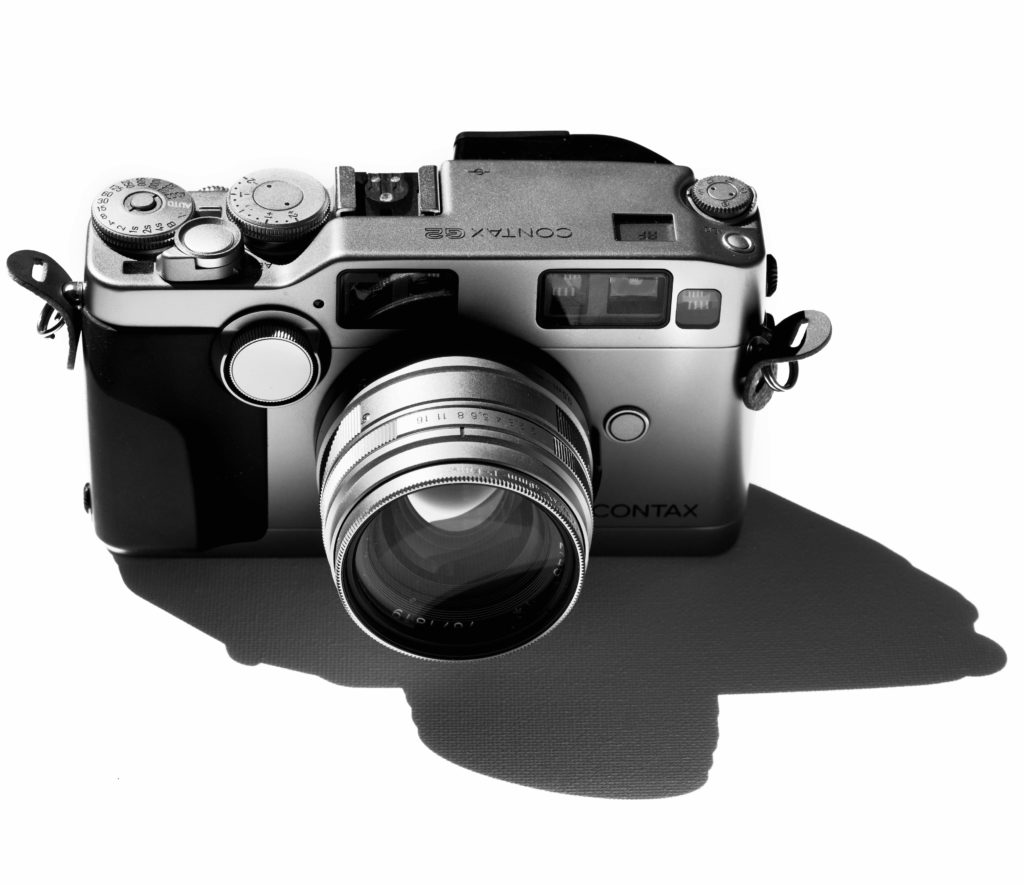
- 1990 first digital camera shipped in the United States is the Dycam Model 1, which comes with a neutral density filter to prevent over exposure in bright settings.
- 1991 The world’s first digital SLR is introduced, The Kodak Professional Digital Camera System (DCS) based on the Nikon F3
- Logitech introduces the Fotoman FM-1, a modified Dycam Model 1, and the first consumer point and shoot camera sold in Europe
- The Konica AiBORG is introduced as the world’s first moving frame auto focus camera. It will go on to achieve infamy as the Konica “Darth Vader” due to its bulbous looks and poor design.
- 1992 Leica introduces the R6.2 SLR, an update of the R6, with a higher top shutter speed and an improved TTL flash mode
- Contax launches the S2 fully mechanical, manual-focus SLR to commemorate the company’s 60th anniversary. It offers only a spot meter and no centre-weighted or matrix metering options
- The Nikonos RS is the world’s first underwater Auto-Focus SLR camera
- 1993 The Vivitar Opus 20 is a late example of a 110 film camera with a modern new look, motor-driven film advance, a built-in flash, and red eye reduction
- 1994 The Apple Quicktake 100 is the first camera to use USB to connect to a computer.
- 1995 The Casio QV-10 is the first camera to incorporate an LCD screen on the back for image preview and playback
- The Ricoh RDC-1 is the first digital camera offering a dedicated movie mode. It is capable of recording 5-second 768×480-pixel clips at 30 frames per second, and saving them in the new MPEG format
- The Nikon D1 is the first fully integrated digital SLR designed from the ground up, rather than a digital modification to a film SLR
- The Minolta RD-175 combines an existing SLR, the Dynax500si Super, with a three way splitter and three separate CCD image sensors which are combined digitally and interpolated to produce a 1.75 megapixel image
- 1996 the Canon PowerShot 600, Canon’s first consumer digital camera, is released featuring a 0.5 megapixel sensor
- The Coolpix 100 is Nikon’s first consumer digital camera. It features a 1/3 megapixel sensor and a PCMCIA interface which enables it slot it into a laptop, where it appears as a removable drive
- Canon introduces the first IXUS APS ultra compact as Canon’s contribution to the launch of the Advance Film System (APS). The model will later form the basis of the Digital IXUS range and is considered a milestone of compact camera design.
- Minolta introduces the TC-1, a high-end, titanium-bodied compact autofocus 35mm camera with the smallest frontal area of any professional-grade compact autofocus camera
- 1997 The Pentax 645N is the first autofocus medium format SLR camera
- Yashica’s first digital camera, the KC-600, is announced
- The Epson PhotoPC 550, the third Epson digital camera and the first Epson to feature an external memory slot for SmartMedia cards, features a microphone to record up to six seconds of sound per photograph
- 1998 Fuji reveal the FUJIX DS-1P at Photokina as “the world’s first camera to save data to a semiconductor memory card”. It captures images using a 400 kilo-pixel CCD that Fuji had began developing in the 70s.
- Leica introduces the M6 TTL, which improves on the M6 with TTL flash and improved ergonomics to become one of the most highly rated film cameras of all time.
- Kodak launches the DC 210, the first affordable megapixel resolution digital camera
- 1999 The Nikon D1 is the first professional digital SLR to displace Kodak’s previously-undisputed reign over the professional market
- Canon introduces the IXUS II in the most successful camera range in the APS market. This success will go on to make IXUS an important trademark in the compact camera market
- Canon launches the first camera in the PowerShot S range, the S10 with a fully retractable zoom lens with built-in lens cover, advanced functions including Spot Metering and AE Lock, and compact, high-density packaging
- 2000 The Fujifilm FinePix S1 Pro is the first interchangeable-lens DSLR to hit the market. It is based on a Nikon N60 with Fuji’s APS-C-format Super CCD Sensor and is capable of creating 6.13 megapixel images
- Nikon reissues the 1958 Nikon S3 rangefinder, the Nikon S3 Year 2000 Limited Edition, with an improved chrome finish as and a redesigned 50mm f1.4 lens with modern coatings
- Canon launches the Digital IXUS range of ultra compact cameras, based on the technology of the PowerShot S10 in a body similar to the APS IXUS II
- The Canon EOS D30 is the first ‘native’ DSLR made in-house by a camera manufacturer with a price tag that is affordable to enthusiasts
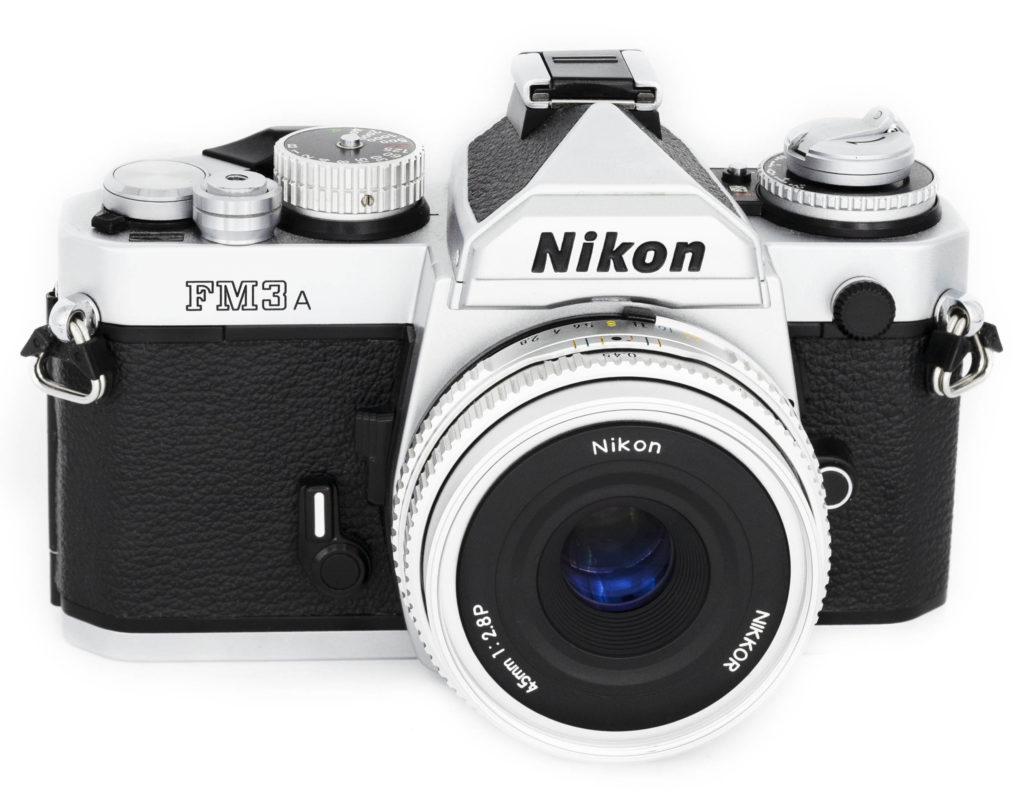
2001-Present
- 2001 Nikon introduces the FM3a, the last manual focus film camera to be launched by a volume manufacturer
- Ricoh launches the GR21, the first compact camera in the world to have a super-wide 21mm wide angle lens
- Pentax introduces the 645NII medium format film camera which adds mirror lock-up to the list of features
- 2002 Contax launches the N Digital the first full frame digital SLR digital camera
- Nikon introduce the D100, which becomes the first digital SLR to score a resounding sales success amongst both professional and serious enthusiast photographers
- Leica departs from the mechanical design of previous M cameras with the introduction of the electronic M7
- 2003 The Olympus E-1 is the first removable lens digital SLR with a lens mount and imaging system specifically designed for digital
- Digital cameras outsell film cameras for the first time
- Leica introduces the all-mechanical MP rangefinder film camera which incorporates many design features of the 1954 M3 and a TTL lightmeter.
- The Minolta Dimage A1 is the first model to stabilise images by shifting the sensor instead of using a lens-based system
- Canon introduces the EOS 300D, arguably the first digital SLR for the mass-market
- 2004 The Epson R-D1 is the first digital rangefinder camera
- Leica makes the detachable DMR (Digital Module R) digital back available, making it possible to transform the Leica R8 and R9 film cameras into digital SLRs
- The Nikon F6 is launched, Nikon’s last high end professional film camera
- 2005 The Canon EOS 5D is the first consumer DSLR to feature a full frame sensor
- Kyocera announces the company is to cease production of film and digital cameras, ending one of oldest brands in photography, Contax.
- 2006 The Flip video camera is released as a “Pure Digital Point & Shoot” video camcorder
- The M8 is Leica’s first digital camera in the rangefinder M series
- 2007 Nikon’s first full frame DSLR, the D3, pushes the ISO range into six figures for the first time – to ISO 102,400
- Microsoft introduces RoundTable, a videoconferencing device with a 360-degree camera with active speaker detection technology, which switches between different meeting participants as they speak.
- 2008 Panasonic releases the Lumix G1, the world’s first mirrorless interchangeable-lens camera
- The Nikon D90 is the first DSLR with HD video recording capabilities
- 2009 Leica launches the M9, a full-frame digital rangefinder compatible with almost all M mount lenses.
- 2010 Samsung introduce the first APS-C format mirrorless camera, the NX10
- Sony introduces the SLT-A55, the first camera to incorporate a translucent mirror design which offers live view with full-time fast phase-detection AF whether in stills or movie shooting.
- 2011 Lytro releases the first pocket-sized consumer light-field camera, capable of refocusing images after they are taken
- Nikon Introduces the J1 and V1 mirrorless cameras which offer on-sensor phase detection autofocus
- 2012 Sony launches the world’s first full frame compact camera – the RX1, with a fixed 35mm F2 lens
- Olympus introduces the OM-D E-M5 with a 5-axis sensor-shifting image stabilisation system – the first of its kind in a consumer camera
- Fujifilm unveils the X-Pro1 mirrorless interchangeable-lens digital with a Hybrid Viewfinder that allows photographers to choose between an optical finder and an electronic view (EVF)
- Canon launches the EOS 6D DSLR which introduces full frame photography to a new generation of photographers who had previously discounted it due to cost
- Rolleiflex’s last TLR model, the FX-N, is introduced at Photokina. It is similar to the Rolleiflex FX, but can focus down to 55cm
- Leica releases the Monochrom, with a monochrome sensor based on the same Kodak CCD sensor as the Leica M9 but without the colour filter array
- 2013 Sony announces the ⍺7 which starts the full frame mirrorless revolution.
- The Android powered Samsung Galaxy NX unsuccessfully attempts to combine the best features of a smartphone and a dedicated camera
- Hasselblad discontinues the last of its film cameras – the V-series 503CW
- 2014 Samsung introduces the mirrorless APS-C NX1, offering new features and higher levels of performance unheard of in the mirrorless market
- Leica launches the Leica T, a camera made from a solid block of milled aluminium with an app-like touchscreen interface that resembles that of a smartphone
- Leica releases the M-A, a purely mechanical 35 mm rangefinder film camera devoid of electronics and based on the designs and features of previous Leica M models
- 2015 Sony announces the first camera to employ a back-side illuminated full frame sensor, the α7R II
- 2016 Leica introduces the Leica Q, a full frame, mirrorless camera with a Summilux f1.7 lens that brings the brand to a new audience
- Hasselblad launches the H6D range of medium format digital cameras with a choice of 50 or 100 megapixel resolutions
- Fujifilm introduce the GFX 50S medium format camera, opening the format to photographers who had never considered it before
- 2017 The Panasonic Lumix DC-GH5 is introduced, bringing high quality low cost video production capabilities to a wider audience
- Intrepid Camera launches its Kickstarter project for a light-weight, low cost, compact, 10X8 large format film camera
- Sony introduce the ⍺9, a mirrorless camera designed to compete with DSLRs in sports and action photography and the first camera to feature Eye Auto Focus that works in continuous AF mode
- Nikon introduces the D850, one of the most technically impressive DSLRs ever made
- 2018 Nikon introduces the Z6 and Z7 full frame mirrorless cameras with the new Z mount.
- Within days of the Nikon Z system launch, Canon launches the EOS R system, its first full frame mirrorless system
- Leica introduce the Leica M10-D, a digital camera without an LCD screen designed to combine the excitement of film with digital technology
- 2019 Worldwide camera shipments drop by 87% 2010-2019, wiping out four decades of growth
- Fujifilm launches the GFX100 with a 100 megapixel medium format, BSI-CMOS sensor
- 2020 The Nikon F6 film SLR is officially discontinued
- Mirrorless cameras overtake DSLRs based on unit volume.
- 2021 Sony introduces the ⍺1, a 50.1 megapixel, 8.6K camera capable of shooting bursts at up to 30 frames per second
- Olympus exits the camera market, completing the sale of its camera business to JIP, a venture capital
- Nikon launches the Z9 which is the first production camera to eliminate the mechanical shutter without the compromise of rolling shutter
- 2022 Leica introduces the M11 rangefinder with a 60MP full-frame back side illuminated sensor
- Leica announces a reissue of the Leica M6 film camera, along with its remake of the original 35mm Summilux
- 2023 Sony launches the a9 III which delivers the world’s first full-frame global shutter sensor, which allows the camera to freeze motion in captured images with a max shutter speed of 1/80,000 second and 120 fps continuous shooting.
- Sony has a prolific year of new releases with six camera launches, solidifying its position as the number one full-frame mirrorless brand.
- Nikon releases the Z8 which delivers the majority of the Z9’s capabilities into a much smaller, more portable camera body
- 2024 Fujifilm announces the launch of the X100VI , the latest model in the popular series of high-end compact digital cameras originally introduced in 2011.
If you spot omissions or errors in this year by year camera timeline, please let me know in the comments.
